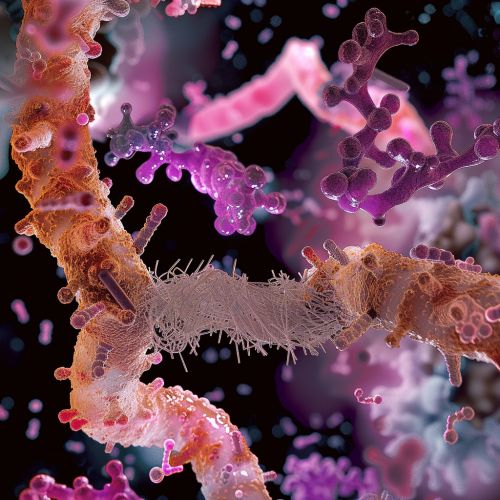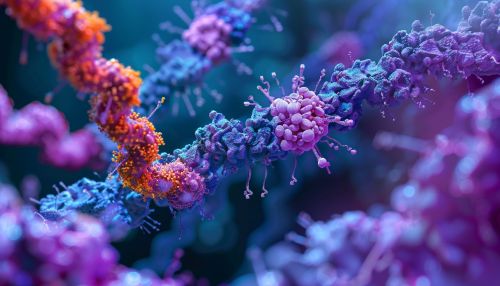RNA transport
Introduction
RNA transport is a critical cellular process involving the movement of ribonucleic acid (RNA) molecules from their site of synthesis to various locations within the cell. This process is essential for the proper functioning of cellular activities, including protein synthesis, gene regulation, and response to environmental stimuli. The transport of RNA is highly regulated and involves a complex interplay of molecular machinery, including RNA-binding proteins, motor proteins, and the cytoskeleton.
Types of RNA Involved in Transport
RNA transport encompasses various types of RNA, each with distinct roles and transport mechanisms:
Messenger RNA (mRNA)
Messenger RNA (mRNA) carries genetic information from DNA to the ribosome, where it serves as a template for protein synthesis. The transport of mRNA from the nucleus to the cytoplasm is a well-studied process that involves several steps, including transcription, processing, export, and localization.
Transfer RNA (tRNA)
Transfer RNA (tRNA) is responsible for delivering amino acids to the ribosome during translation. tRNA molecules are synthesized in the nucleus and transported to the cytoplasm, where they participate in protein synthesis.
Ribosomal RNA (rRNA)
Ribosomal RNA (rRNA) is a key component of ribosomes, the cellular machinery responsible for protein synthesis. rRNA is transcribed in the nucleolus and assembled into ribosomal subunits, which are then transported to the cytoplasm.
Small Nuclear RNA (snRNA) and Small Nucleolar RNA (snoRNA)
Small nuclear RNA (snRNA) and small nucleolar RNA (snoRNA) are involved in the processing and modification of other RNA molecules. snRNA is primarily involved in splicing, while snoRNA guides chemical modifications of rRNA. Both types of RNA are synthesized in the nucleus and transported to specific subnuclear compartments.
Mechanisms of RNA Transport
The transport of RNA molecules within the cell is a highly regulated process that involves several key mechanisms:
Nuclear Export
RNA molecules synthesized in the nucleus must be exported to the cytoplasm to perform their functions. This process involves the nuclear pore complex (NPC), a large protein complex that spans the nuclear envelope. RNA export is mediated by export receptors, such as exportin-1 (CRM1), which recognize specific RNA sequences and facilitate their passage through the NPC.
Cytoplasmic Transport
Once in the cytoplasm, RNA molecules are transported to specific cellular locations. This transport is often mediated by motor proteins, such as kinesin and dynein, which move along the cytoskeleton. The transport of mRNA, for example, involves the formation of ribonucleoprotein (RNP) complexes that are recognized by motor proteins and directed to their destination.
RNA Localization
RNA localization refers to the targeting of RNA molecules to specific subcellular regions. This process is crucial for the spatial regulation of gene expression and involves the recognition of RNA localization signals by RNA-binding proteins. For instance, the localization of β-actin mRNA to the leading edge of migrating cells is essential for cell motility.
RNA-Binding Proteins and Transport Complexes
RNA-binding proteins (RBPs) play a central role in RNA transport by recognizing and binding to specific RNA sequences or structures. These proteins form transport complexes that facilitate the movement of RNA molecules within the cell.
hnRNPs
Heterogeneous nuclear ribonucleoproteins (hnRNPs) are a family of RBPs involved in various aspects of RNA metabolism, including transport. hnRNPs bind to pre-mRNA and influence its processing, export, and localization.
SR Proteins
Serine/arginine-rich (SR) proteins are a group of RBPs that regulate splicing and also participate in mRNA export. SR proteins interact with export receptors and the NPC to facilitate the nuclear export of spliced mRNA.
Motor Proteins
Motor proteins, such as kinesin and dynein, are essential for the cytoplasmic transport of RNA. These proteins move along microtubules and transport RNA-containing RNP complexes to specific cellular locations.
Regulation of RNA Transport
The transport of RNA is tightly regulated at multiple levels to ensure the proper expression and localization of genes.
Post-Transcriptional Modifications
Post-transcriptional modifications, such as 5' capping, splicing, and 3' polyadenylation, influence RNA transport. These modifications are recognized by export receptors and RBPs, which facilitate the export and localization of RNA.
RNA Localization Signals
RNA localization signals are specific sequences or structures within RNA molecules that direct their transport to particular cellular regions. These signals are recognized by RBPs, which mediate the transport process.
Cellular Signaling Pathways
Cellular signaling pathways regulate RNA transport in response to environmental cues. For example, the localization of certain mRNAs can be influenced by signaling pathways that control the activity of motor proteins and RBPs.
Functional Significance of RNA Transport
RNA transport is essential for various cellular processes and has significant implications for cell function and development.
Protein Synthesis
The transport of mRNA to ribosomes is critical for protein synthesis. Proper localization of mRNA ensures that proteins are synthesized at the right place and time within the cell.
Gene Regulation
RNA transport contributes to gene regulation by controlling the spatial and temporal expression of genes. The localization of specific mRNAs allows for localized protein synthesis, which is important for processes such as cell polarity and differentiation.
Cellular Response to Stimuli
RNA transport enables cells to respond to environmental stimuli by rapidly altering gene expression. For example, the localization of mRNAs encoding stress response proteins allows for a quick and efficient response to stress conditions.
Pathological Implications of Defective RNA Transport
Defects in RNA transport can lead to various diseases and disorders, highlighting the importance of this process for cellular function.
Neurodegenerative Diseases
Abnormal RNA transport has been implicated in neurodegenerative diseases, such as amyotrophic lateral sclerosis (ALS) and spinal muscular atrophy (SMA). Mutations in genes encoding RBPs and motor proteins can disrupt RNA transport and lead to neuronal dysfunction.
Cancer
Dysregulation of RNA transport can contribute to cancer development and progression. Altered expression of RBPs and export receptors can affect the localization and stability of mRNAs encoding oncogenes and tumor suppressors.
Viral Infections
Viruses can hijack the host cell's RNA transport machinery to facilitate their replication. For example, the export of viral RNAs is often mediated by host export receptors, which are co-opted by viral proteins.


Conclusion
RNA transport is a fundamental cellular process that ensures the proper expression and localization of genes. It involves a complex interplay of molecular machinery, including RNA-binding proteins, motor proteins, and the cytoskeleton. The regulation of RNA transport is crucial for various cellular functions, including protein synthesis, gene regulation, and response to environmental stimuli. Defects in RNA transport can lead to a range of diseases, highlighting the importance of this process for cellular health and function.
